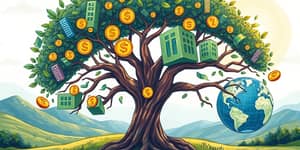
Financial freedom is the ultimate goal for many individuals seeking to break free from the cycle of living paycheck to paycheck. It is defined as the ability to afford your desired lifestyle without succumbing to stress related to money. Yet recent surveys reveal that only 11% of Americans feel they have reached their personal vision of financial liberty. With high credit card balances and minimal savings, the journey often feels out of reach, but it need not be impossible.
While the dream of declaring “no more work” appeals to nearly a third of adults, the majority remain constrained by debt and lack of emergency funds. Credit card debt in the U.S. has climbed to a staggering $1.031 trillion, and 40% of people lack a basic savings cushion. Even so, over half of Americans report optimism about their financial futures. This blend of challenge and hope sets the stage for deliberate action and sustainable progress.
Before crafting a personalized roadmap, it is essential to grasp the broader economic picture. Skyrocketing interest rates can make debt repayment feel like a losing battle, while inflation erodes purchasing power. At the same time, advances in technology and access to investment platforms have democratized opportunities to grow wealth. Recognizing both hurdles and headwinds creates a balanced perspective and primes you for targeted strategies.
These statistics underscore common priorities. For many, achieving sufficient surplus cash elevates quality of life, while the psychological relief of not juggling bills can transform daily living. Setting clear, measurable objectives aligned with these pillars unleashes both motivation and direction for long-term success.
Mapping out a path to financial independence requires a structured, step-by-step approach. Each stage builds on the previous one, reinforcing good habits and compounding results over time. Embracing this journey as a personal mission can shift money management from obligation to opportunity.
Each action plays a vital role. For example, maintaining an emergency fund protects against setbacks, while consistent investment harnesses the power of compounding. Over time, these habits form the bedrock for long-term wealth accumulation and stability.
Stories of individuals who have navigated this path provide inspiration and practical lessons. The popular FIRE movement—Financial Independence, Retire Early—demonstrates how a combination of frugal living and strategic investing can accelerate freedom. House hacking, side hustles, and index fund portfolios illustrate diverse avenues for building passive income streams.
Consider Liz and Jeff, who confronted $180,000 in consumer and student loan debt. Rather than drastic austerity, they focused on leveraging existing skills to increase their income and aligned spending with core values. Within five years, they were debt-free and saving aggressively for retirement.
Then there are Mark and Lisa, a couple who dedicated a decade to incremental real estate investments. By reinvesting rental cash flow into additional properties, they created a portfolio sufficient to cover living expenses and fund new ventures.
David’s journey began in a corporate role. He transitioned to consulting, gradually growing his client base and reinvesting profits into dividend stocks. His experience highlights the power of entrepreneurship combined with passive income through dividends.
No two paths are identical, but common milestones mark increasing levels of autonomy. Tracking these stages helps maintain momentum and celebrate victories along the way.
Achieving financial freedom is as much an inner journey as it is a numerical one. Mindset drives behavior, and behavior steers outcomes. Cultivating patience, resilience, and adaptability empowers you to stay focused even when markets shift or personal circumstances change.
Developing a habit of continuous learning—whether through books, podcasts, or mentorship—reinforces sound financial decision-making skills. Surrounding yourself with a community that shares similar goals can provide accountability, encouragement, and fresh ideas for growth.
The road to financial freedom is rarely smooth. Unexpected expenses, market downturns, and lifestyle inflation can derail plans. Recognizing these pitfalls early and building buffers—both emotional and financial—helps you stay on track.
Resist the pressure to compare your journey with others; personal definitions of success vary. Commit to a plan that aligns with your values and revise it when priorities shift. Overcoming fear of failure and embracing setbacks as learning opportunities fosters long-term progress.
Ultimately, crafting your own path toward financial freedom involves deliberate planning, disciplined execution, and ongoing reflection. By taking measured steps—assessing your situation, setting goals, eliminating debt, and investing wisely—you pave the way for lasting financial peace of mind and the freedom to pursue what truly matters. The journey may span years, but with each milestone reached, you gain confidence and control over your future. Start today and chart your course toward a life unshackled by financial worry.
References













